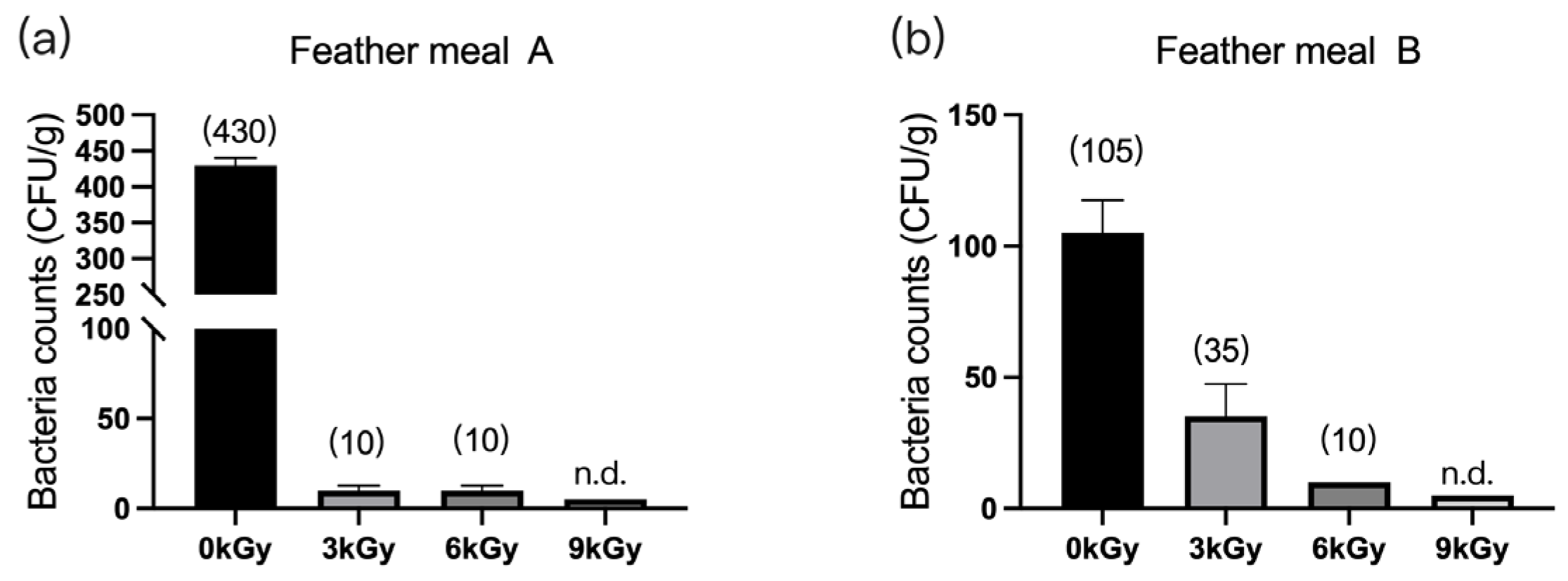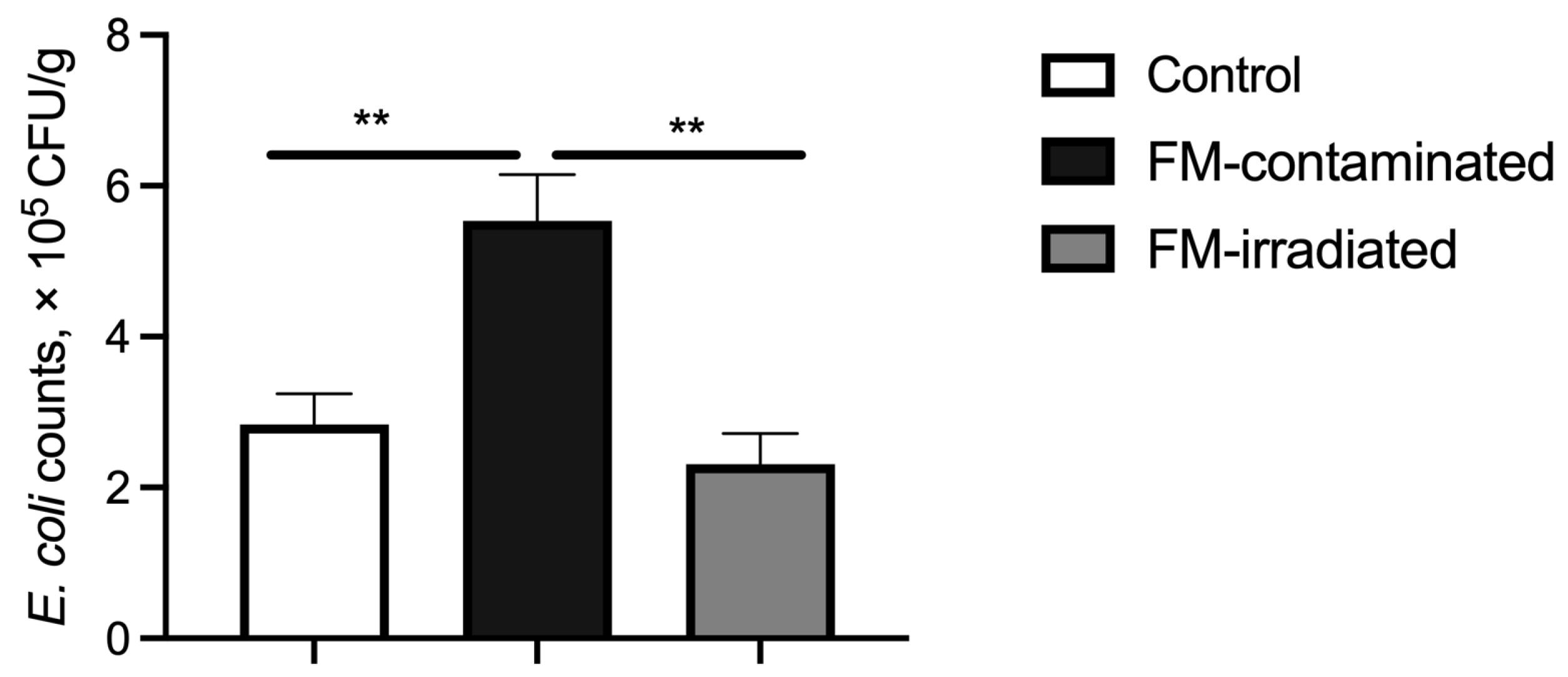1. Introduction
The ban on antibiotics use in animal feed has led to health problems in swine production that must be overcome to avoid economic losses. In particular, the immature gastrointestinal tract of weaning piglets predisposes them to susceptibility to disease [
1]. Environmental factors, such as bacteria in feed, are among the primary exogenous factors that negatively impact the health of piglets [
2]. Indeed, numerous bacteria are present in animal feed, which is vulnerable to the introduction of bacteria due to the inclusion of contaminated raw ingredients and/or because of contamination during transportation and feed processing [
3,
4]. The use of protein feed of animal origin, such as fish, meat, and bone meal and animal plasma protein, is of great concern because it is vulnerable to contamination by pathogenic bacteria such as
E. coli and
Salmonella [
3,
5,
6]. For example, the global epidemic of African swine fever virus has raised concern among swine producers about the use of porcine plasma protein in feed [
5].
There are several ways of reducing the bacteria counts in animal feed, such as heat treatment [
7], acidification [
8], and ultraviolet irradiation [
9]. However, these methods cannot eliminate bacteria completely and sometimes negatively impact nutritional value [
10]. An alternative treatment is irradiation sterilization, in which electromagnetic waves generated by ionizing radiation, such as electron beams, X-rays, and gamma (γ)-rays, are used [
11,
12,
13]. Irradiation treatment is a process that involves energic, physical, and chemical changes but does not cause the irradiated substance to produce emissivity. Irradiation causes energy output, and the irradiated material absorbs that energy. It is usually expressed as gray, 1 gray, or 1 kg of irradiated material absorbed per 1 joule of energy (1 Gy = 1 J kg
−1), which is similar in nature to the heat generated by heat (infrared) or microwave energy [
14]. Recently, Li et al. reported that γ-ray irradiation is an effective method for reducing bacterial counts in feed and food [
15]. They found that it can even modify the structure of dietary polysaccharides by cleaving their glycosidic bonds and exposing more functional groups with increased mobility [
15]. However, the optimal level of γ-ray irradiation to apply to lower the bacterial counts in feed remains unclear. Additionally, the effect of γ-ray irradiation treatment on the feeding value of contaminated feed material in the animals consuming it is unknown.
To address these issues, we conducted two trials. In trial 1, we tested the effects of different levels of γ-ray irradiation treatment on 14 types of feed to identify the optimal irradiation dosage. In trial 2, we treated contaminated fishmeal with γ-ray irradiation to investigate the role of bacterial counts in the feed on the growth performance of weaning piglets.
4. Discussion
The gut of an animal is in direct contact with microorganisms in a feed; thus, the number and diversity of microorganisms in a feed is directly related to intestinal health and the digestion and absorption of nutrients. This is particularly true when immature piglets encounter pathogenetic microbiota such as
E. coli [
26]. In the present study, we found that fishmeal contaminated with
E. coli. and a high bacteria load impaired the growth performance of piglets. However, γ-ray irradiation at a dose of 6 kGy effectively eliminated most of the bacteria in the feed and abrogated the negative effects of bacterial contamination on the growth performance of piglets.
In the present study, the bacteria counts in the feeds from different sources were quite variable. The number of microbial colonies in fishmeal A was as high as 91,000 CFU/g, whereas fishmeal samples B and C contained only 295 and 35 CFU/g, respectively. The number of microbial colonies in soybean meal sample C was as high as 34,000 CFU/g, but that of soybean meal A was only 4350 CFU/g. These results indicate that fishmeal and soybean meal from different sources differ greatly in microbial counts due to the effects of processing technology, storage time, storage conditions, packaging, transportation routes, and other factors [
27,
28]. Fishmeal sample A also had greater TVB-N content, which consists of alkaline nitrogenous substances such as ammonia and amines that are produced via the microbial decomposition of protein, suggesting that the microbes were active during processing and storage [
29]. In particular, we detected the presence of
E. coli in the fishmeal samples.
E. coli is commonly found in the lower digestive tract of warm-blooded organisms [
30]. Most strains of
E. coli are not harmful, but some can cause severe food poisoning. For example, Shiga-toxin-producing
E. coli is a bacterium that can be found in raw or undercooked ground meat products. It can cause serious foodborne illness with symptoms such as abdominal cramps and diarrhea, with the latter sometimes progressing to bloody diarrhea (hemorrhagic colitis) [
31]. In swine production,
E. coli is one of the leading causes of diarrhea among newborn and weaning piglets, as it impairs the integrity of the intestinal mucosal barrier [
30,
32,
33].
At present, biosafety is the primary problem that plagues the application of protein feedstuffs of animal origin, such as porcine plasma protein, fish meal, meat meal, and feather meal, in livestock production, mainly because the pathogenic microorganisms in feed raw materials cannot be killed using the conventional processing techniques [
27,
28,
34]. γ-ray irradiation has been widely used to reduce the number of bacteria in food [
35], but the appropriate treatment dose is not clear, and little is known about the effect of the γ-ray irradiation treatment of feed on weaning piglets. Therefore, the purpose of our study was to assess the effect of different doses of γ-ray irradiation on the of bacteria in feed.
We found that γ-ray irradiation at doses of 3–9 kGy was quite effective in eliminating bacteria in the feed. Most of the feed bacteria were below the detection level at a dose of 6 kGy, and no bacteria were detectable in all of the feedstuffs treated with 9 kGy. We also found that the optimal dose of γ-ray irradiation varied for different feedstuffs. For fish meal and meat meal, all of the microorganisms were entirely eliminated at 6 kGy, but microbes were still detectable in feather meal and soybean meal at this dose, although the counts were quite low. One possible explanation for the observed differences is that the feeds differ in their bulk density. Meat meal and fishmeal are fluffy and have low bulk density, allowing γ-rays to easily penetrate entire samples of these types of meal. In contrast, soybean meal, feather powder, and other feeds have greater bulk density, so a larger γ-ray irradiation dose may be required to eliminate the bacteria completely.
Although the bulk density of the multivitamin premixes was small and the material was fluffy, elimination of microorganisms in vitamin complexes B and C required 9 kGy of irradiation, likely due to their composition. Vitamins contain numerous double bonds, meaning that they can significantly increase the energy absorption of γ-rays [
36]. This might explain why the higher dose of γ-ray irradiation resulted in decreased content of vitamins B1 and C [
36]. However, γ-ray irradiation had no effect on the vitamin A and E content in the samples, and this finding requires further investigation.
Another objective of our study was to investigate the effect of high bacteria loads and E. coli contamination, with or without γ-ray irradiation, on the feed value of fishmeal fed to weaning piglets. To exclude the effect of bacteria in the basal diet on the growth performance of piglets, this diet was irradiated with γ-rays to eliminate microorganisms. All irradiated feed used in this experiment was stored in sealed receptacles, and microbial counts were conducted after γ-ray treatment. However, the feed could have been contaminated by microorganisms from the environment during transportation, storage, and feeding. However, we ignored the impact of these microorganisms in the environment on the feeding value of the feeds provided to the piglets because the interval between the unpackaging of the feed and feeding was short.
We found that the piglets fed the diet containing 6% fish meal with a higher bacteria load and contaminated with
E. coli had significantly lower average daily weight gain. This decreased growth performance might have been due in part to the lower feed intake (−58 g/d), although the difference was not statistically significant. The lower feed intake might be linked to the diarrhea caused by the presence of
E. coli in the feed. Serum c-reactive protein, which is a biomarker of bacterial infection in swine [
37], was present in the piglets fed the
E. coli-contaminated fishmeal, but the level was same as that of the control group when the fishmeal was treated with γ-ray irradiation. The immature intestinal tract of weaning piglets is highly vulnerable to environmental factors [
2,
38], and pathogenic
E. coli is one of the leading causes of post-weaning diarrhea [
30,
32,
33]. Accordingly, we found that the number of viable
E. coli counts in the feces was significantly increased when the weaning piglets consumed the diet containing
E. coli-contaminated fishmeal. The number of viable
E. coli counts in the feces is considered to be an important parameter of the gut health of weaning piglets [
39], and our results showed that
E. coli-contaminated fishmeal was harmful to the weaning piglets.
γ-ray irradiation has been widely applied in various fields, including food sterilization [
40], healthcare [
41], and the packaging materials sector [
42]. On the other hand, the cost of using γ-ray irradiation for sterilization falls within an acceptable range. For instance, irradiating fishmeal at a dose of 9 kGy only adds a modest 5.6% to the overall cost. Importantly, there is no potential radiation residue in the feed that could harm animals. The development of the civil nuclear power industry in China [
43] is likely to stimulate the use of γ-ray irradiation in livestock production and the feed industry. However, there are concerns regarding the environmental safety of γ-ray irradiation. One primary concern is the potential harm to the environment due to ionizing radiation. Gamma rays, a form of ionizing radiation, have the ability to damage living organisms, including plants and animals. Therefore, it is critical to ensure the safe containment and control of the radiation source. Moreover, the use of gamma ray irradiation can generate radioactive waste, which must be managed safely. Proper storage, handling, and disposal of this waste are essential to prevent environmental contamination. Facilities employing gamma ray irradiation must have suitable shielding and containment structures in place to prevent the leakage of radiation into the environment. These facilities are subject to regulatory requirements to ensure their safety.
Nevertheless, our study revealed that weaning piglets fed diets containing pathogenic microorganisms had impaired gut function and growth performance. Similar to our results, DeRouchey et al. previously reported that irradiation improved the feed value of blood meal with respect to nursery pig performance [
44]. Therefore, it is important to eliminate harmful bacteria in feed to protect weaning piglets from environmental stress. We found that the contamination of fishmeal with
E. coli can be completely alleviated via γ-ray irradiation and that the negative effect of
E. coli-contaminated fishmeal on weaning piglets can be totally reversed via γ-ray irradiation of the feed. These results suggest that γ-ray irradiation is sufficiently suitable and safe for attenuating biosafety concerns about feeds of animal origin. However, whether microorganisms other than
E. coli that have non-pathogenic potential affect the growth performance and gut health of weaning piglets remains unknown.













